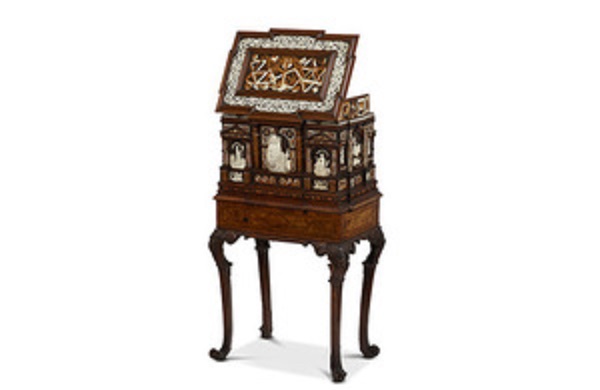Arts Minister Michael Ellis announces temporary export bar so that a buyer can be found for 16th century casket worth £750,000.
- One of the earliest known pieces of Kunstkammer furniture in the UK at risk of being lost abroad unless a UK buyer can be found
Arts Minister Michael Ellis has placed a temporary export bar on a 16th century marquetry casket from the historic Newbattle Abbey, Scotland, in a bid to keep it in the country.
The treasure, considered one of the most important early pieces of South German furniture in the country, is at risk of being lost unless a buyer can be found to match the £750,000 asking price.
Created in 1565, the German Renaissance casket features engraved ivory and bone panels and gilded metalwork. It is believed to be one of the earliest known pieces of German ‘Kunstkammer’ furniture in existence.
The concept of the Kunstkammer or ‘cabinet of curiosities’ first emerged in the 16th century to showcase precious, rare and exotic objects to display the owner’s status and scholarship. The casket is a rare, dated example and would have formed part of a prestigious collection.
Arts Minister Michael Ellis said:
Throughout history cabinets of curiosities have been used to hold countless precious treasures. Now it is this incredibly rare casket that is itself the treasure. I hope that we can find a buyer to keep this remarkable piece of furniture in the country.
The intricately decorated stand accompanying this casket is in the style of James Moore, cabinet-maker to the Royal household of King George I from 1714 – 1726.
It is believed that the casket is the only piece of its kind in a British collection. Comparable examples of German Renaissance caskets survive in the Kunsthistorisches Museum in Vienna and the Metropolitan Museum of Art in New York.
While it is difficult to identify a designer, the expert panel agreed that the work could be associated with the city of Nuremberg and dated to the 1560s. The casket provides important evidence that the Nuremberg cabinet-makers rivalled those of Augsburg in the production of high-quality marquetry furniture in South Germany during this period.
The RCEWA made its recommendation on the grounds of the cabinet’s outstanding aesthetic importance and for the opportunities it offers for the study of German renaissance cabinet-making. The Committee noted that the cabinet was exceptionally well crafted.
Committee Member Christopher Rowell said:
This remarkably beautiful and highly wrought small cabinet of architectural design, inlaid with panels of figurative and perspectival marquetry, with elegantly chased gilt bronze mounts, was probably made in Nuremberg around 1565.
It is the sole piece of furniture of its kind in Great Britain and the most elaborate of only a dozen pieces of sixteenth-century German furniture to be decorated with marquetry depicting 3D geometric solids or illusionistic polyhedra. The perspectival wood, ivory, bone and mother-of-pearl marquetry derives from Italian and German engravings. One of the panels is dated 1565.
The cabinet was designed as a repository of precious small works of art. Its British carved walnut cabriole-legged support was made for it around 1730, so it has been in this country since then. It may have descended to the Marquesses of Lothian from Frederick V, Elector Palatine, the so-called ‘Winter King’ of Bohemia, son-in-law of James VI of Scotland and I of England and brother-in-law of Charles I.
The Newbattle casket was lent to prominent exhibitions in the nineteenth century. It is to be hoped that this great rarity, which has been in the country for nearly 300 years, can be retained in Britain.
The decision on the export licence application for the casket will be deferred until 11 July 2019. This may be extended until 11 October 2019 if a serious intention to raise funds to purchase the casket is made at the recommended price of £750,000.










